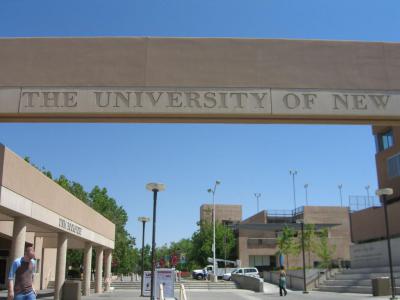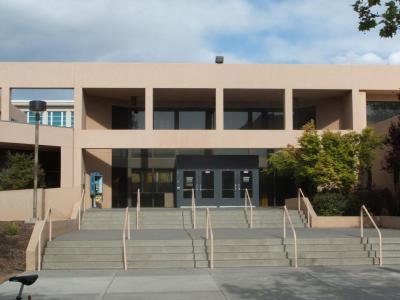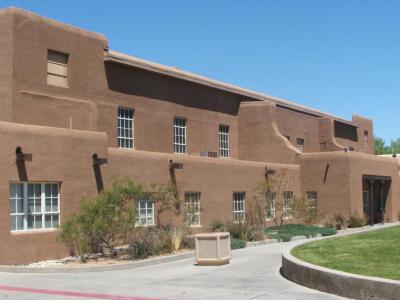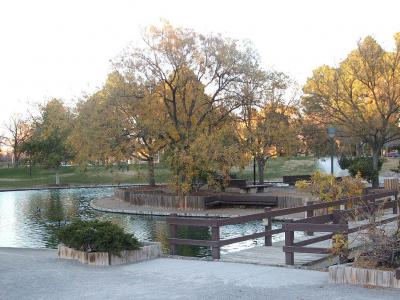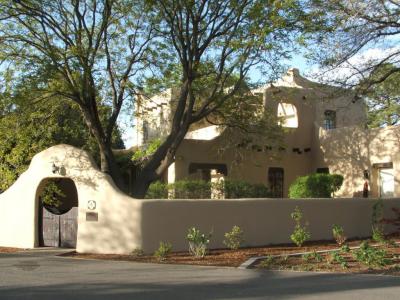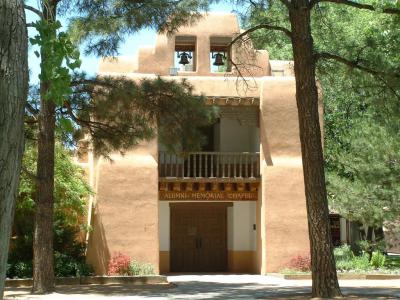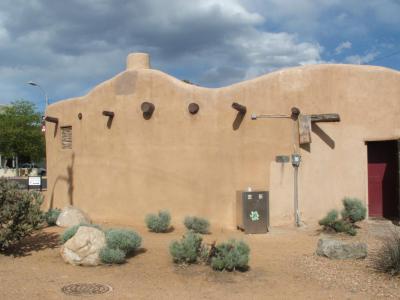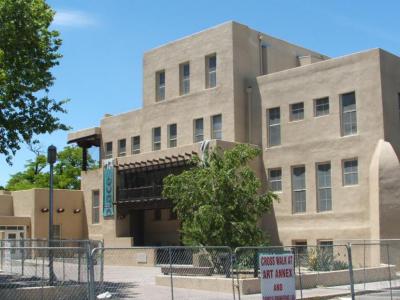
University of New Mexico Walking Tour (Self Guided), Albuquerque
Founded in 1889, The University of New Mexico (UNM) is a renowned public research institution. Its branch campuses are scattered throughout the state while the main campus is located in Albuquerque. A good number of spots on this campus deserve a special note, either from an architectural or cultural standpoint, and we encourage you to explore them.
A must-go-to for students and visitors alike, looking for textbooks, school supplies, and UNM merchandise, is the University of New Mexico Bookstore. This is a hub for all things academic and spirited.
In turn, Zimmerman Library is the heart of academic research on campus. With its extensive collection and resources, it's a valuable resource for students and scholars.
Johnson Gymnasium Arena: This is where students and community members gather to watch thrilling sporting events and support the UNM Lobos teams. The atmosphere during the games is electric, making it an unforgettable experience. Another gymnasium on campus, Carlisle Gymnasium, is home to the university's dance center.
When it's time to unwind and enjoy nature, head to the Duck Pond at UNM. This tranquil spot is a perfect place for reflection and relaxation.
Meanwhile, the University of New Mexico Art Museum showcases an impressive collection of art, including pieces from various cultures and time periods. Similarly, the Maxwell Museum of Anthropology offers a fascinating insight into the world of anthropology, showcasing artifacts and exhibits from various cultures.
The President's House at UNM is an iconic residence, symbolizing the university's leadership and commitment to excellence.
Alumni Memorial Chapel is a beautiful place for weddings, memorials, and spiritual gatherings. It holds a special place in the hearts of many alumni.
Another unique adobe building on campus, adding to the rich architectural heritage of UNM, is Estufa.
Hodgin Hall, with its historic charm, houses administrative offices and serves as a center for important university functions.
Finally, Central Avenue and Nob Hill further ahead offer a vibrant off-campus experience with restaurants, shops, and cultural attractions.
As you can see, the University of New Mexico is a diverse and dynamic institution with a lot to offer. Whether you're interested in academics, sports, art, or culture, a self-guided walk around the UNM Albuquerque campus can guarantee you the time well spent altogether. So, go for it!
A must-go-to for students and visitors alike, looking for textbooks, school supplies, and UNM merchandise, is the University of New Mexico Bookstore. This is a hub for all things academic and spirited.
In turn, Zimmerman Library is the heart of academic research on campus. With its extensive collection and resources, it's a valuable resource for students and scholars.
Johnson Gymnasium Arena: This is where students and community members gather to watch thrilling sporting events and support the UNM Lobos teams. The atmosphere during the games is electric, making it an unforgettable experience. Another gymnasium on campus, Carlisle Gymnasium, is home to the university's dance center.
When it's time to unwind and enjoy nature, head to the Duck Pond at UNM. This tranquil spot is a perfect place for reflection and relaxation.
Meanwhile, the University of New Mexico Art Museum showcases an impressive collection of art, including pieces from various cultures and time periods. Similarly, the Maxwell Museum of Anthropology offers a fascinating insight into the world of anthropology, showcasing artifacts and exhibits from various cultures.
The President's House at UNM is an iconic residence, symbolizing the university's leadership and commitment to excellence.
Alumni Memorial Chapel is a beautiful place for weddings, memorials, and spiritual gatherings. It holds a special place in the hearts of many alumni.
Another unique adobe building on campus, adding to the rich architectural heritage of UNM, is Estufa.
Hodgin Hall, with its historic charm, houses administrative offices and serves as a center for important university functions.
Finally, Central Avenue and Nob Hill further ahead offer a vibrant off-campus experience with restaurants, shops, and cultural attractions.
As you can see, the University of New Mexico is a diverse and dynamic institution with a lot to offer. Whether you're interested in academics, sports, art, or culture, a self-guided walk around the UNM Albuquerque campus can guarantee you the time well spent altogether. So, go for it!
How it works: Download the app "GPSmyCity: Walks in 1K+ Cities" from Apple App Store or Google Play Store to your mobile phone or tablet. The app turns your mobile device into a personal tour guide and its built-in GPS navigation functions guide you from one tour stop to next. The app works offline, so no data plan is needed when traveling abroad.
University of New Mexico Walking Tour Map
Guide Name: University of New Mexico Walking Tour
Guide Location: USA » Albuquerque (See other walking tours in Albuquerque)
Guide Type: Self-guided Walking Tour (Sightseeing)
# of Attractions: 12
Tour Duration: 2 Hour(s)
Travel Distance: 3.6 Km or 2.2 Miles
Author: doris
Sight(s) Featured in This Guide:
Guide Location: USA » Albuquerque (See other walking tours in Albuquerque)
Guide Type: Self-guided Walking Tour (Sightseeing)
# of Attractions: 12
Tour Duration: 2 Hour(s)
Travel Distance: 3.6 Km or 2.2 Miles
Author: doris
Sight(s) Featured in This Guide:
- University of New Mexico Bookstore
- Johnson Gymnasium Arena
- University of New Mexico Art Museum
- Carlisle Gymnasium
- Duck Pond at UNM
- Zimmerman Library
- President's House (University of New Mexico)
- Alumni Memorial Chapel
- Maxwell Museum of Anthropology
- Estufa
- Hodgin Hall
- Central Avenue and Nob Hill
1) University of New Mexico Bookstore
The University of New Mexico bookstore is located on the University of New Mexico campus next to Yale Park. The UNM bookstore offers books, course material and technology for students, but it is also a popular spot for tourists. Visitors to Albuquerque can buy UNM themed clothing, artwork, accessories and even architecture kits.
The history of the bookstore is unique in that it was not well established until more than 100 years after the founding of the university. When the first UNM building was constructed in 1889, the bookstore was placed in an army barracks.
The bookstore moved to several places around the campus before finally ending up in the basement of the Student Union in the 1950s. Some 20 years later it moved to the campus's biology building. It would stay in that spot for another 20 years. The current building has been the home of the UNM bookstore since 1996.
The history of the bookstore is unique in that it was not well established until more than 100 years after the founding of the university. When the first UNM building was constructed in 1889, the bookstore was placed in an army barracks.
The bookstore moved to several places around the campus before finally ending up in the basement of the Student Union in the 1950s. Some 20 years later it moved to the campus's biology building. It would stay in that spot for another 20 years. The current building has been the home of the UNM bookstore since 1996.
2) Johnson Gymnasium Arena
The University of New Mexico's Johnson Gymnasium is a versatile arena with a seating capacity of 4,000, established in 1957. Initially, it served as the New Mexico Lobos basketball team's primary venue until the opening of The Pit in 1966. Presently, it acts as the home floor for the Lobo volleyball squad, and it is named after Roy Johnson, the former coach of the Lobos basketball team.
In a historic move on March 18, 2015, the arena hosted its first-ever women's basketball game for the New Mexico Lobos, where they faced North Dakota in the first round of the Women's Basketball Invitational. Due to a scheduling conflict with a Professional Bull Riders event, the team's usual arena, The Pit, was unavailable. The Lobos secured a win against North Dakota and proceeded to the second round, where they suffered a loss to Oral Roberts, held at the same venue.
In a historic move on March 18, 2015, the arena hosted its first-ever women's basketball game for the New Mexico Lobos, where they faced North Dakota in the first round of the Women's Basketball Invitational. Due to a scheduling conflict with a Professional Bull Riders event, the team's usual arena, The Pit, was unavailable. The Lobos secured a win against North Dakota and proceeded to the second round, where they suffered a loss to Oral Roberts, held at the same venue.
3) University of New Mexico Art Museum
The University of New Mexico Art Museum, located in Albuquerque, is a museum that is dedicated to preserving and showcasing the visual arts. The museum is part of the University of New Mexico and is housed in the Center for the Arts building on the university campus. The museum was established in 1963 and has since become one of the leading art institutions in the region.
The museum's permanent collection includes over 30,000 pieces of art, ranging from contemporary art to historic artifacts. The collection is divided into several categories, including American and European painting and sculpture, Latin American art, photography, and works on paper. Some of the most notable pieces in the collection include works by Georgia O'Keeffe, Robert Rauschenberg, and Diego Rivera.
In addition to its permanent collection, the museum also hosts temporary exhibitions throughout the year. These exhibitions feature the work of local, national, and international artists and are curated to highlight different themes and styles of art. The museum also offers educational programs for all ages, including tours, lectures, and workshops.
One of the unique features of the University of New Mexico Art Museum is its focus on the art and culture of the Southwest. The museum's collection includes a large number of works by Native American artists, as well as pieces that showcase the cultural heritage of New Mexico and the surrounding region. The museum's commitment to preserving and showcasing the art of the Southwest has made it an important institution for the study and appreciation of regional art.
The University of New Mexico Art Museum is an important cultural institution in Albuquerque and the surrounding region. Its impressive collection of art, commitment to showcasing the art of the Southwest, and educational programs make it a valuable resource for anyone interested in the visual arts.
The museum's permanent collection includes over 30,000 pieces of art, ranging from contemporary art to historic artifacts. The collection is divided into several categories, including American and European painting and sculpture, Latin American art, photography, and works on paper. Some of the most notable pieces in the collection include works by Georgia O'Keeffe, Robert Rauschenberg, and Diego Rivera.
In addition to its permanent collection, the museum also hosts temporary exhibitions throughout the year. These exhibitions feature the work of local, national, and international artists and are curated to highlight different themes and styles of art. The museum also offers educational programs for all ages, including tours, lectures, and workshops.
One of the unique features of the University of New Mexico Art Museum is its focus on the art and culture of the Southwest. The museum's collection includes a large number of works by Native American artists, as well as pieces that showcase the cultural heritage of New Mexico and the surrounding region. The museum's commitment to preserving and showcasing the art of the Southwest has made it an important institution for the study and appreciation of regional art.
The University of New Mexico Art Museum is an important cultural institution in Albuquerque and the surrounding region. Its impressive collection of art, commitment to showcasing the art of the Southwest, and educational programs make it a valuable resource for anyone interested in the visual arts.
4) Carlisle Gymnasium
Located in Albuquerque, the Carlisle Gymnasium is an indoor arena situated on the campus of the University of New Mexico. Initially serving as the home court of the New Mexico Lobos basketball team from 1928 until 1957, when the larger Johnson Gymnasium was constructed, the building also acted as the original venue of the New Mexico Symphony Orchestra. Presently, it houses the university's Elizabeth Waters Center for Dance.
The architectural design of the Carlisle Gymnasium was executed by the firm of Gaastra, Gladding, and Johnson in the Pueblo Revival style, which was the official style for all new buildings on campus. To creatively adopt the style, the architects utilized stepped massing, vigas, and other Pueblo elements to conceal the gymnasium's rectilinear form. The building was named in honor of Hugh Carlisle, a UNM student who passed away in World War I. The Carlisle Gymnasium was recognized in 1988 and added to both the New Mexico State Register of Cultural Properties and the National Register of Historic Places.
The architectural design of the Carlisle Gymnasium was executed by the firm of Gaastra, Gladding, and Johnson in the Pueblo Revival style, which was the official style for all new buildings on campus. To creatively adopt the style, the architects utilized stepped massing, vigas, and other Pueblo elements to conceal the gymnasium's rectilinear form. The building was named in honor of Hugh Carlisle, a UNM student who passed away in World War I. The Carlisle Gymnasium was recognized in 1988 and added to both the New Mexico State Register of Cultural Properties and the National Register of Historic Places.
5) Duck Pond at UNM
The Duck Pond at the University of New Mexico in Albuquerque has a fascinating history that spans several decades. Originally designed by Garret Eckbo, a famous landscape architect, the pond was supposed to have an artificial waterfall, a bridge with a trellis cover, and a Wisteria covering to imitate Japanese-style architecture. However, due to budget constraints, the original plan was scaled down, and the pond ended up being only two and a half feet deep for safety reasons.
When it was first constructed, the pond was called University Pond or simply The Lake. However, it was soon dubbed the Duck Pond by students who were enamored with the body of water. The Daily Lobo, a local newspaper, criticized the pond heavily and referred to it as the No-Name Pond and a concrete lake. Professor Emeritus T. M. Pearce even suggested bulldozing it and returning it to nature, but despite the initial backlash, the pond became a popular attraction on campus and in the city.
The pond was filled for the first time in February of 1976, and soon after, ducks, goldfish, and trout were introduced into the water. However, the ducks quickly became overpopulated, and the wild fish struggled to acclimate to the warm water. During cleaning in the winter of 1984, the ducks were relocated to the South Campus Golf Course Pond, and new ducks were donated to the Duck Pond.
Today, the Duck Pond is a highlight of the Albuquerque area, attracting visitors from across the city. It is surrounded by colorful reclining chairs and comfortable wooden benches, making it an ideal place to relax, study, or converse. The pond is also home to a diverse population of wildlife, including ducks, geese, and turtles. In the spring, the edges of the pond are lined with purple and white irises, while in the fall, the leaves turn golden brown, creating a serene and magical landscape. The pond is also a popular spot for photography, especially during golden hour.
When it was first constructed, the pond was called University Pond or simply The Lake. However, it was soon dubbed the Duck Pond by students who were enamored with the body of water. The Daily Lobo, a local newspaper, criticized the pond heavily and referred to it as the No-Name Pond and a concrete lake. Professor Emeritus T. M. Pearce even suggested bulldozing it and returning it to nature, but despite the initial backlash, the pond became a popular attraction on campus and in the city.
The pond was filled for the first time in February of 1976, and soon after, ducks, goldfish, and trout were introduced into the water. However, the ducks quickly became overpopulated, and the wild fish struggled to acclimate to the warm water. During cleaning in the winter of 1984, the ducks were relocated to the South Campus Golf Course Pond, and new ducks were donated to the Duck Pond.
Today, the Duck Pond is a highlight of the Albuquerque area, attracting visitors from across the city. It is surrounded by colorful reclining chairs and comfortable wooden benches, making it an ideal place to relax, study, or converse. The pond is also home to a diverse population of wildlife, including ducks, geese, and turtles. In the spring, the edges of the pond are lined with purple and white irises, while in the fall, the leaves turn golden brown, creating a serene and magical landscape. The pond is also a popular spot for photography, especially during golden hour.
6) Zimmerman Library
The Zimmerman Library is located on the north side of the University of New Mexico's Smith Plaza. It is a four-floor library that houses materials relating to education, humanities, social sciences and government.
This was the main library for the campus when it was built in 1938. It was designed by John Gaw Meem in a Spanish-Pueblo Revival architectural style. Meem's design was based on Spanish missions in the area along with Pueblo architecture. Many of the interior features were designed by local Native American artists in order to stay true to the Pueblo influence.
One of the most distinctive features of the Zimmerman Library is its nine-story tower. This tower was built to provide a home to the collections, but it is no longer in use. The library provides occasional tours of the tower, but these are generally reserved for students.
Visitors can access the library from 9 AM through 6 PM during weekdays and from 1 PM through 6 PM on Sundays. The Zimmerman Library is closed on Saturdays.
This was the main library for the campus when it was built in 1938. It was designed by John Gaw Meem in a Spanish-Pueblo Revival architectural style. Meem's design was based on Spanish missions in the area along with Pueblo architecture. Many of the interior features were designed by local Native American artists in order to stay true to the Pueblo influence.
One of the most distinctive features of the Zimmerman Library is its nine-story tower. This tower was built to provide a home to the collections, but it is no longer in use. The library provides occasional tours of the tower, but these are generally reserved for students.
Visitors can access the library from 9 AM through 6 PM during weekdays and from 1 PM through 6 PM on Sundays. The Zimmerman Library is closed on Saturdays.
7) President's House (University of New Mexico)
Located at the northeast corner of Roma Avenue and Yale Boulevard on the University of New Mexico campus, the President's House was built in 1930 in the Spanish Pueblo Revival style by architect Miles Brittelle. Nowadays, it is known as the University House. This adobe residence features vertical metal casement windows with Watson wood lintels and exposed vigas on the second story. The rustic second-story balcony is formed by vigas and supported by a log beam and posts. The building has undergone several additions since its original construction, all in the Pueblo style, which upholds the integrity of the original building. John Gaw Meem designed an addition to the house in 1952. Its shape resembles multiple squares and rectangles.
The President's House is one of the six buildings on the University of New Mexico campus included in the nomination. This residence is an outstanding example of residential Spanish Pueblo Revival-style architecture and was even used as a representative example of this style in a major survey of American building styles. It was listed on the New Mexico State Register of Cultural Properties and the National Register of Historic Places in 1988. Despite various additions and renovations, all of them have been faithful to the style and architectural integrity of the original building.
The President's House is one of the six buildings on the University of New Mexico campus included in the nomination. This residence is an outstanding example of residential Spanish Pueblo Revival-style architecture and was even used as a representative example of this style in a major survey of American building styles. It was listed on the New Mexico State Register of Cultural Properties and the National Register of Historic Places in 1988. Despite various additions and renovations, all of them have been faithful to the style and architectural integrity of the original building.
8) Alumni Memorial Chapel
The Alumni Memorial Chapel is a distinctive building on the University of New Mexico campus. It is a popular space for weddings, celebrations and other special events due to the beauty of the building and its gardens.
The chapel was built in 1962 as a tribute to UNM alumni who were lost during service in the nation's wars. Each name is listed on the south wall of the chapel. The garden also has commemorative tiles that bear the images of alumni.
John Gaw Meem was the architect who designed the Alumni Memorial Chapel. Born in Brazil and based out of Santa Fe, Meem designed a number of buildings on the UNM campus in his distinctive southwestern style. As Meem retired in 1956, the Alumni Memorial Chapel was his last official design.
Visitors tourinf the interior of the chapel will see carillon bells that were donated by the Chi Omega sorority, an altar screen crafted by numerous southwest artists and a pipe organ with 432 pipes.
The chapel was built in 1962 as a tribute to UNM alumni who were lost during service in the nation's wars. Each name is listed on the south wall of the chapel. The garden also has commemorative tiles that bear the images of alumni.
John Gaw Meem was the architect who designed the Alumni Memorial Chapel. Born in Brazil and based out of Santa Fe, Meem designed a number of buildings on the UNM campus in his distinctive southwestern style. As Meem retired in 1956, the Alumni Memorial Chapel was his last official design.
Visitors tourinf the interior of the chapel will see carillon bells that were donated by the Chi Omega sorority, an altar screen crafted by numerous southwest artists and a pipe organ with 432 pipes.
9) Maxwell Museum of Anthropology
Founded in 1932 as the Museum of Anthropology of the University of New Mexico, the Maxwell Museum of Anthropology was the first public museum in Albuquerque. Its purpose was to showcase the expanding collection of artifacts collected from field schools of archaeological research associated with the UNM Anthropology Department, the School of American Research, and the Museum of New Mexico.
Initially, exhibits were housed in UNM's Rodey Hall until its demolition in 1971. The museum was subsequently moved to Scholes Hall in 1935 and then to its current location in 1961. In 1972, Dorothy and Gilbert Maxwell, philanthropists, funded a major construction project to expand the museum facilities, and it was renamed in their honor. Since then, the museum has become a nationally renowned research center and a significant regional museum.
The museum has five exhibit areas that host permanent and rotating exhibits, showcasing the human cultural experience. The Ancestors permanent exhibit depicts human evolution over four million years, featuring life-size models of human ancestors. The People of the Southwest permanent exhibit portrays the cultural heritage of the American Southwest over eleven thousand years, displaying artifacts from various cultures, including Mimbres, Ancestral Puebloan, and Puebloan, as well as exhibits showcasing UNM fieldwork in New Mexico, including a reconstruction of excavation at Chaco Canyon.
The museum's North Gallery, Bawden Gallery (named after Garth Bawden, museum director from 1985 to 2005), and the Ortiz Center Gathering Space (named after the late Alfonso Ortiz, a noted UNM anthropology professor) host changing exhibits showcasing artifacts from the museum's extensive collection, as well as traveling exhibits. The museum's courtyard features a 46-foot (14 meters)-high totem pole that was brought to the museum from British Columbia in 1941.
Initially, exhibits were housed in UNM's Rodey Hall until its demolition in 1971. The museum was subsequently moved to Scholes Hall in 1935 and then to its current location in 1961. In 1972, Dorothy and Gilbert Maxwell, philanthropists, funded a major construction project to expand the museum facilities, and it was renamed in their honor. Since then, the museum has become a nationally renowned research center and a significant regional museum.
The museum has five exhibit areas that host permanent and rotating exhibits, showcasing the human cultural experience. The Ancestors permanent exhibit depicts human evolution over four million years, featuring life-size models of human ancestors. The People of the Southwest permanent exhibit portrays the cultural heritage of the American Southwest over eleven thousand years, displaying artifacts from various cultures, including Mimbres, Ancestral Puebloan, and Puebloan, as well as exhibits showcasing UNM fieldwork in New Mexico, including a reconstruction of excavation at Chaco Canyon.
The museum's North Gallery, Bawden Gallery (named after Garth Bawden, museum director from 1985 to 2005), and the Ortiz Center Gathering Space (named after the late Alfonso Ortiz, a noted UNM anthropology professor) host changing exhibits showcasing artifacts from the museum's extensive collection, as well as traveling exhibits. The museum's courtyard features a 46-foot (14 meters)-high totem pole that was brought to the museum from British Columbia in 1941.
10) Estufa
The University of New Mexico campus houses a historical edifice named the Estufa, which derives its name from the Pueblo Indian's assembly room, also known as a stove or a warm room. Constructed in 1907-08 by a local social fraternity, it has been the primary meeting place for the Pi Kappa Alpha chapter since 1915. The Estufa's origin is steeped in fraternity tradition, with rumors that no woman has ever set foot inside. This revered building is recognized in both the New Mexico State Register of Cultural Properties and the National Register of Historic Places.
The Estufa is designed after a kiva, a ceremonial meeting place utilized by the Pueblo people. The adobe structure has thick walls and a solitary room without any windows, featuring seating around the perimeter. University president, William G. Tight, guided the construction of the building, advocating for Pueblo Revival architecture on campus. As one of the early structures in New Mexico to embrace this style, the Estufa has a unique historical significance.
The Estufa is designed after a kiva, a ceremonial meeting place utilized by the Pueblo people. The adobe structure has thick walls and a solitary room without any windows, featuring seating around the perimeter. University president, William G. Tight, guided the construction of the building, advocating for Pueblo Revival architecture on campus. As one of the early structures in New Mexico to embrace this style, the Estufa has a unique historical significance.
11) Hodgin Hall
Located in Albuquerque, Hodgin Hall is a historical building that has had various names over time, including the University Building, Main Building, and Administration Building. Constructed in 1892, it was the first structure to be erected on the University of New Mexico (UNM) campus and served as the university's sole building for almost ten years. The original design of the building was done by Jesse Wheelock in the Richardsonian Romanesque style. However, the building's roof developed structural issues, which gave the then-university president, William Tight, the chance to have it renovated to his preferred Pueblo Revival style in 1908.
The renovated Hodgin Hall showcases stepped, asymmetrical massing, stuccoed walls, vigas, and other elements that are typical of traditional Pueblo and mission architecture. Being among the first Pueblo Revival buildings in New Mexico, Hodgin Hall played a significant role in establishing this style at both the university and regionally. Although the building faced the threat of demolition in the 1970s, an alumni-led fundraising campaign ensured its preservation and restoration. The Alumni Association and Alumni Relations offices of the university have occupied Hodgin Hall since 1983. Additionally, the building has earned a spot in both the New Mexico State Register of Cultural Properties and the National Register of Historic Places.
The renovated Hodgin Hall showcases stepped, asymmetrical massing, stuccoed walls, vigas, and other elements that are typical of traditional Pueblo and mission architecture. Being among the first Pueblo Revival buildings in New Mexico, Hodgin Hall played a significant role in establishing this style at both the university and regionally. Although the building faced the threat of demolition in the 1970s, an alumni-led fundraising campaign ensured its preservation and restoration. The Alumni Association and Alumni Relations offices of the university have occupied Hodgin Hall since 1983. Additionally, the building has earned a spot in both the New Mexico State Register of Cultural Properties and the National Register of Historic Places.
12) Central Avenue and Nob Hill
The Nob Hill neighborhood in Albuquerque is a residential area with a commercial district running along Central Avenue, formerly known as U.S. Route 66. The area, located just east of the University of New Mexico, was developed between 1925 and 1950 and has become a popular destination for tourists and shoppers. Nob Hill is well-known for its mix of unique, locally owned businesses and has been described as Albuquerque's "hippest, funkiest retail and entertainment district," as well as the "heart of Albuquerque's Route 66 culture." The neighborhood's name is derived from Nob Hill in San Francisco.
The commercial strip in Nob Hill began to take shape in the 1930s, as the surrounding neighborhoods grew and Central Avenue became a popular route for travelers, especially after it was designated as U.S. Route 66 in 1937. The area catered to both travelers and residents, resulting in a diverse mix of businesses, including the Aztec Motel, El Oriente Court, Modern Auto Court, Lobo Theater, De Anza Motor Lodge, and Jones Motor Company.
Today, Nob Hill offers a variety of locally owned shops, galleries, bars, and restaurants, as well as some chain stores like Buffalo Exchange and Starbucks. While most commercial activity in the past was limited to the west of Carlisle, new developments are gradually expanding eastward along Central Avenue.
The commercial strip in Nob Hill began to take shape in the 1930s, as the surrounding neighborhoods grew and Central Avenue became a popular route for travelers, especially after it was designated as U.S. Route 66 in 1937. The area catered to both travelers and residents, resulting in a diverse mix of businesses, including the Aztec Motel, El Oriente Court, Modern Auto Court, Lobo Theater, De Anza Motor Lodge, and Jones Motor Company.
Today, Nob Hill offers a variety of locally owned shops, galleries, bars, and restaurants, as well as some chain stores like Buffalo Exchange and Starbucks. While most commercial activity in the past was limited to the west of Carlisle, new developments are gradually expanding eastward along Central Avenue.
Walking Tours in Albuquerque, New Mexico
Create Your Own Walk in Albuquerque
Creating your own self-guided walk in Albuquerque is easy and fun. Choose the city attractions that you want to see and a walk route map will be created just for you. You can even set your hotel as the start point of the walk.
Downtown Historical Buildings Walking Tour
The one-of-a-kind character of Albuquerque is the result of many different forces and centuries of history that have shaped the city. The core of Central Albuquerque is what most of the locals considered “downtown” – a place they lived, worked, shopped, governed and entertained themselves in for almost 80 years, since the arrival of the railroad in 1880.
The vibrant architectural... view more
Tour Duration: 1 Hour(s)
Travel Distance: 1.7 Km or 1.1 Miles
The vibrant architectural... view more
Tour Duration: 1 Hour(s)
Travel Distance: 1.7 Km or 1.1 Miles
Albuquerque Old Town Walk
The history of human habitation on the site of present-day Albuquerque, New Mexico reaches back 12,000 years. Long before the “Breaking Bad” and “Better Call Saul” TV series made a splash for Albuquerque worldwide, the Paleo-Indians inhabited the region. By the time European settlers had arrived in the 1500s, approximately 20 indigenous tribes lined the 60-mile stretch of the Rio Grande... view more
Tour Duration: 1 Hour(s)
Travel Distance: 1.5 Km or 0.9 Miles
Tour Duration: 1 Hour(s)
Travel Distance: 1.5 Km or 0.9 Miles
The Most Popular Cities
/ view all
